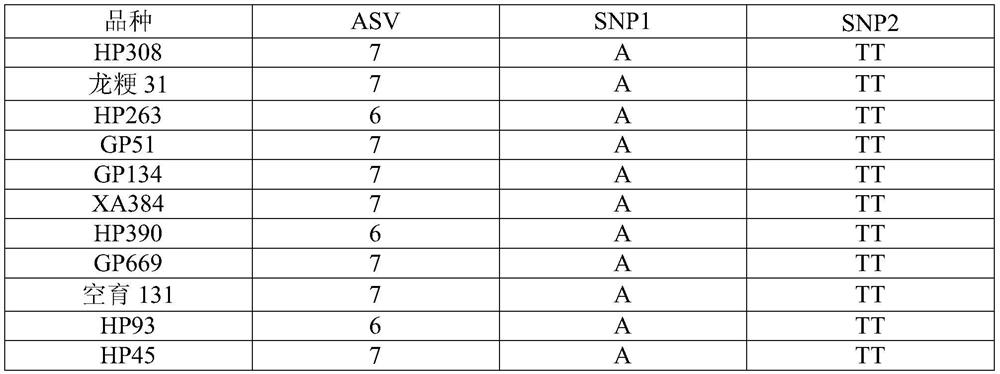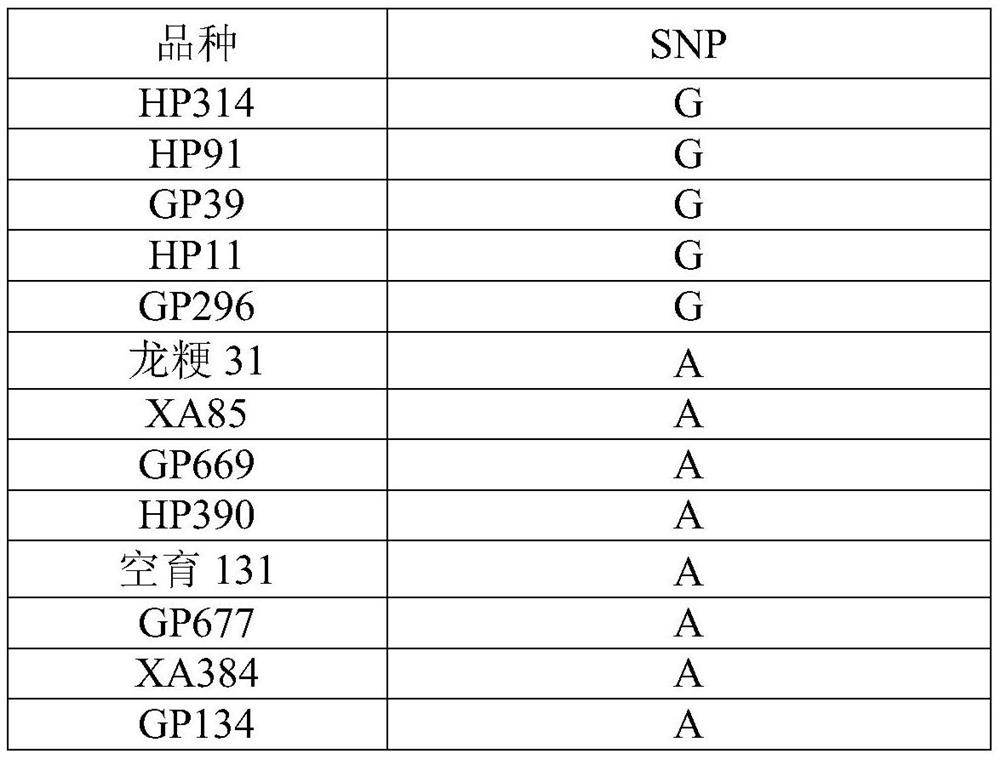Gene marker for distinguishing rice starch quality
A gene marker and gene technology, which is applied in the determination/inspection of microorganisms, DNA/RNA fragments, recombinant DNA technology, etc., can solve the problems of lower transcript content, lower intron splicing efficiency, lower amylose content, etc.
- Summary
- Abstract
- Description
- Claims
- Application Information
AI Technical Summary
Problems solved by technology
Method used
Image
Examples
Embodiment 1
[0036] Example 1: Screening of gene markers affecting rice starch gelatinization temperature
[0037] 1. The SNP site sequence screening of the ALK gene includes the following steps:
[0038] 1) extracting the genomic DNA of the rice plant to be tested;
[0039] 2) with primers selected from the following table, PCR amplification is carried out to rice genomic DNA;
[0040] ALK-SNP-F CGCAGCACAACAGCAAGGTGCG SEQ ID NO: 7 ALK-SNP-R GGTCTCTTCACCATTGGTACTTG SEQ ID NO: 8
[0041] PCR reaction system is calculated as 20μl: 10X PCR reaction buffer 2μ1, 25mM MgSO 4 0.8μl, 2mM dNTP 2μl, 5μM forward primer (-F) and reverse primer (-R) 1.2μl each, genomic DNA 20ng, KOD-Plus polymerase 0.4μl, plus ddH 2 O is made up to 20 μl.
[0042] The PCR reaction conditions were as follows: 94°C pre-denaturation for 2 minutes, 94°C denaturation for 15 seconds, 55°C annealing for 30 seconds, 68°C extension for 1 minute, a total of 35 cycles; 68°C incubation for 5 minutes. ...
Embodiment 2
[0062] Example 2: Screening of gene markers affecting amylose content of rice starch
[0063] 1. The SNP site sequence screening of the Wx gene includes the following steps:
[0064] 1) extracting the genomic DNA of the rice plant to be tested;
[0065] 2) with primers selected from the following table, PCR amplification is carried out to rice genomic DNA;
[0066] Wx-SNP-F GAGGTGGCCGGTGGTGTTGTCCTTC SEQ ID NO: 9 Wx-SNP-R GAAGATTCCATAATGTACCAGG SEQ ID NO: 10
[0067] PCR reaction system is calculated as 20μl: 10X PCR reaction buffer 2μ1, 25mM MgSO 4 0.8μl, 2mM dNTP 2μl, 5μM forward primer (-F) and reverse primer (-R) 1.2μl each, genomic DNA 20ng, KOD-Plus polymerase 0.4μl, plus ddH 2 O is made up to 20 μl.
[0068] The PCR reaction conditions were as follows: 94°C pre-denaturation for 2 minutes, 94°C denaturation for 15 seconds, 55°C annealing for 30 seconds, 68°C extension for 1 minute, a total of 35 cycles; 68°C incubation for 5 minutes.
[00...
PUM
 Login to View More
Login to View More Abstract
Description
Claims
Application Information
 Login to View More
Login to View More - R&D
- Intellectual Property
- Life Sciences
- Materials
- Tech Scout
- Unparalleled Data Quality
- Higher Quality Content
- 60% Fewer Hallucinations
Browse by: Latest US Patents, China's latest patents, Technical Efficacy Thesaurus, Application Domain, Technology Topic, Popular Technical Reports.
© 2025 PatSnap. All rights reserved.Legal|Privacy policy|Modern Slavery Act Transparency Statement|Sitemap|About US| Contact US: help@patsnap.com



